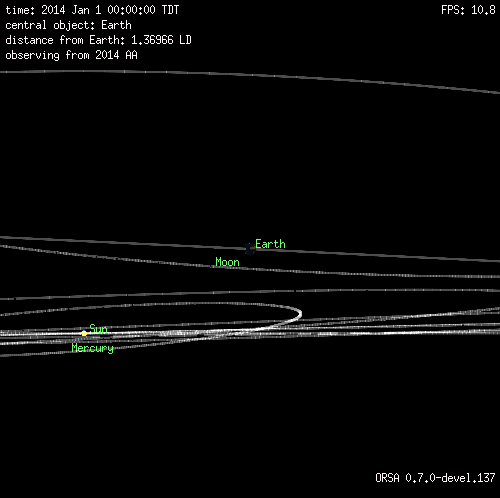This was very likely the last trip around the Sun for the Earth-crossing asteroid 2014 AA, according to calculations by several teams of astronomers and published online earlier today on the IAU’s Minor Planet Center. Discovered just yesterday by the Catalina Sky Survey, the estimated 3-meter-wide Apollo asteroid was supposed to clear Earth today by a razor-thin margin of about 611 km (380 miles)… but it’s now looking like it didn’t quite make it.
The diagram above, via Asteroid Initiatives’ Twitter feed, shows a projected path probability pattern for 2014 AA’s re-entry locations. No eyewitness accounts have yet been reported, and if anyone knows of any surveillance cameras aimed in those directions that might have captured footage of a bolide feel free to share that info below in the comments and/or with @AsteroidEnergy on Twitter.
Other calculations put the entry point anywhere between western Africa and Central America.
According to the MPEC report the asteroid “was unlikely to have survived atmospheric entry intact.”
Watch an animation below showing 2014 AA’s point-of-view as it met Earth. (Video courtesy of Pasquale Tricarico, senior scientist at the Planetary Science Institute in Tucson, AZ.)

JPL’s Near-Earth Object program classifies Apollo asteroids as “Earth-crossing NEAs with semi-major axes larger than Earth’s (named after asteroid 1862 Apollo).” And while not an Earth-shattering event (fortunately!) this is just another small reminder of why we need to keep watch on the sometimes-occupied path our planet takes around the Sun!
Read the NASA/JPL news release on 2014 AA here.
h/t to Dr. John Barentine for the heads-up!
UPDATE: Based on infrasound analysis by Peter Brown of the University of Western Ontario, 2014 AA likely impacted the atmosphere over the Atlantic around 0300 UTC at 40° west, 12° north — about 1,900 miles east of Caracas, Venezuela. The impact released the equivalent of 500 to 1,000 tons (0.5 – 1 kiloton) of TNT, but far above a remote and uninhabited area. Read more on Sky & Telescope here.


Smaller than the Chelyabinsk meteorite, which was estimated to be 18 meters or so, this pup would still put a major dent in your day were it to actually land anywhere nearby! Interesting to note and good to hear it was seen prior to it’s demise but still, it made me want to keep my hard hat and gold undies nearby…. ~@; )
Not much danger of a 3m body reaching the ground as anything more than a few kilograms of meteorites, none landing at anything other than terminal velocity. Bodies this size hit the Earth’s atmosphere once a year or more.
Depends entirely on the elemental composition of the object as not all meteors are alike….
No, it doesn’t. A body that size could be anything from a fragile carbonaceous chondrite to a solid piece of iron, and it has virtually no chance of making it to the ground with more than a few percent of its original mass, and none of its original velocity.
…entry angle and speed relative to the Earth are also key.
They’re certainly key to the survival of meteorites. But for a body this size, they don’t make any difference with respect to it reaching the ground intact, or carrying any of its original velocity.
Yep, lets not forget to keep watching those asteroids! A lot of good it will do us if a 1km wide one where to hit… one hell of a show!!
It only shows how slow we are to react, we get to know about it after it burnt up or hit the atlantic, hope it didn’t kill any fish!
a very, very small asteroid that would have very small chance of hitting the ground intact… no need to react.